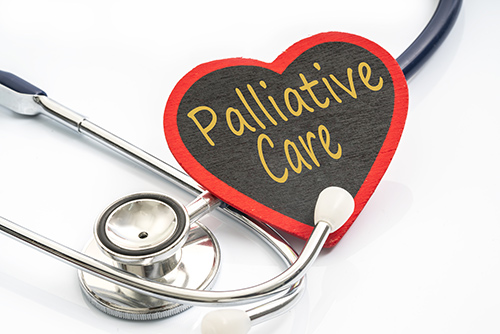The word “palliative” literally translates to mean “relieving pain.”

Palliative (pronounced “pal-ee-uh-tiv”) care is often confused with other types of elder care, and most especially with hospice care, but this type of care is highly specialized and has its own appropriate place within the greater menu of senior care services.
In this article, you will learn more about what palliative care is and what it is not, what payment options may be available to you, what this type of treatment involves and the goal of this type of care. Finally, learn about the many benefits pain relief care can offer to an elderly loved one.
What is Pain Relieving Care for the Elderly?
The need for pain management for chronic illness or disease can occur at any age and stage of life.

However, this type of care can be particularly important in the golden years where the goal is to extend quality of life as a priority.
Pain relief care can occur at any location. Care receivers may receive treatment for pain at home, in a rehabilitation facility, in an independent living or assisted care facility, in a clinic or hospital setting, in a cancer care or other specialized care center or elsewhere as may be needed.
Most importantly, treatment may not only focus on alleviating physical pain but also on easing emotional pain, mental pain and even spiritual pain. To this end, care providers can include religious leaders and hospital chaplains, psychologists and social workers, massage therapists and acupuncture practitioners as well as nurses and physicians.
What Is the Goal of Pain Relief Care?
The main focus and number one goal of this type of specialized care option is to help the care receiver to feel better in the short and long term.

Rather than aiming to cure the issue causing the pain, palliative care instead focuses on easing symptoms of the issue. Symptoms may include physical pain, psychological or emotional pain and sometimes spiritual pain as well.
Sleep disturbance, nausea, breathing difficulties, appetite loss, movement challenges and mood issues including anxiety, depression, fear and even hopelessness can all be addressed during the course of care.
What Does This Type of Care Involve?
One of the most unique aspects of this type of care is that it is completely tailored to the needs of each patient. Even when the diagnosis is familiar – cancer, heart disease, ALS, kidney failure, HIV/AIDS or something else – the needs of each patient can be utterly unique.

For medical care needs, the care consultation may revolve around conversations with medical professionals, nurses and physicians and surgeons.
For issues of dementia, Alzheimer’s, memory impairment and similar health concerns, the care consultation may include physicians, psychologists and social workers.
The care consultation for chronic progressive health illness diagnoses that can include ALS, Parkinson’s disease, HIV/AIDS and similar issues can include physicians, psychiatrists, psychologists, movement and massage therapists, alternative medicine and holistic practitioners and others who can help chart the course of pain management care as the illness progresses.
List of Benefits of Pain Relieving Care
Treating chronic illness from a quality of life perspective means the patient is truly in charge as best as is possible of directing their own long term care.
If the long-term care plan is for an individual who is not able to fully express their own care needs (for example, someone suffering with dementia) then any existing end-of-life or advance directive documents can also provide guidance to meet the patient’s pain control needs.
Benefits can also extend past that offered directly for elderly care. Often caregivers – loved ones and family members – begin to feel over-extended by the needs of someone with long-term care needs.
By adding other trained and qualified pain management professionals to the palliative care team, caregivers can have time to rest and regroup, take care of their other daily responsibilities and also have a regular outlet to seek personal support as they continue to participate in their elderly loved one’s care.
This is a general list of known benefits of pain relief care:
– Eases pain on multiple levels (physical, mental, emotional, spiritual).
– Provides relief for regular caregivers, including connecting caregivers to local resources from ride sharing to grocery shopping and more.
– Focuses on improving quality of life over remission of symptoms for long-term illnesses deemed “terminal.”
– Opens up the floor for a dialogue about other end of life issues.
– Can begin as soon as a diagnosis is confirmed, even if the progression of the illness is projected to be slow.
– Launches a dialogue about other important issues including end-of-life wishes.
– Is flexible to meet the needs of the individual whether at a facility, in hospital, at home or elsewhere.
– Can provide a smooth transition into hospice and true end-of-life care.
Pain Relieving Care vs End of Life Care
One of the areas where ongoing confusion exists is in separating care that is palliative in nature from true hospice (end of life) care.

End of life care is typically offered when the individual is thought to have six months or less to live. This is quite different than pain management care, which can begin the moment a diagnosis is confirmed and continue as long as the need is there.
In some cases, the individual may need medical care for a chronic health condition that causes pain but is not necessarily terminal. Medications, physical therapy, psychological counseling and spiritual counseling can all be critical components of managing a long-term care need that is not necessarily terminal but is also not thought to be curable.
End of life care is a very specific type of care that generally begins once a diagnosis confirms that the individual has six months or less to live. End of life care typically provides support and care for the individual and their immediate caregivers and family members as needed. The end of life care team can include physicians, nurse practitioners, social workers, psychologists and religious leaders as is appropriate to meet the patient’s needs. In addition, a palliative care team can be incorporated for seniors who require additional pain management.
How to pay for Pain Relieving Care
The good news for family members and patients receiving elderly care is that Medicare typically does cover pain relieving care. One notable benefit of receiving this care that Medicare recognizes is that it can help keep the individual out of the hospital and comfortable at home.
This care is also generally covered under both public and private insurance plans. Medicare Part A may cover care at home and in the local community and may include medical elderly care, social and spiritual care services. Medicare Part B may include supplies and/or services for disease management as well.
For individuals who have Medicaid, pain relieving care is often also covered on a long term basis and may include home care as well as medications and other care needs.
By taking the time to understand how pain relieving care can help both the affected individual and caregivers and loved ones, it adds another layer of support and help that can ease the burden for every individual involved in a loved one’s care.